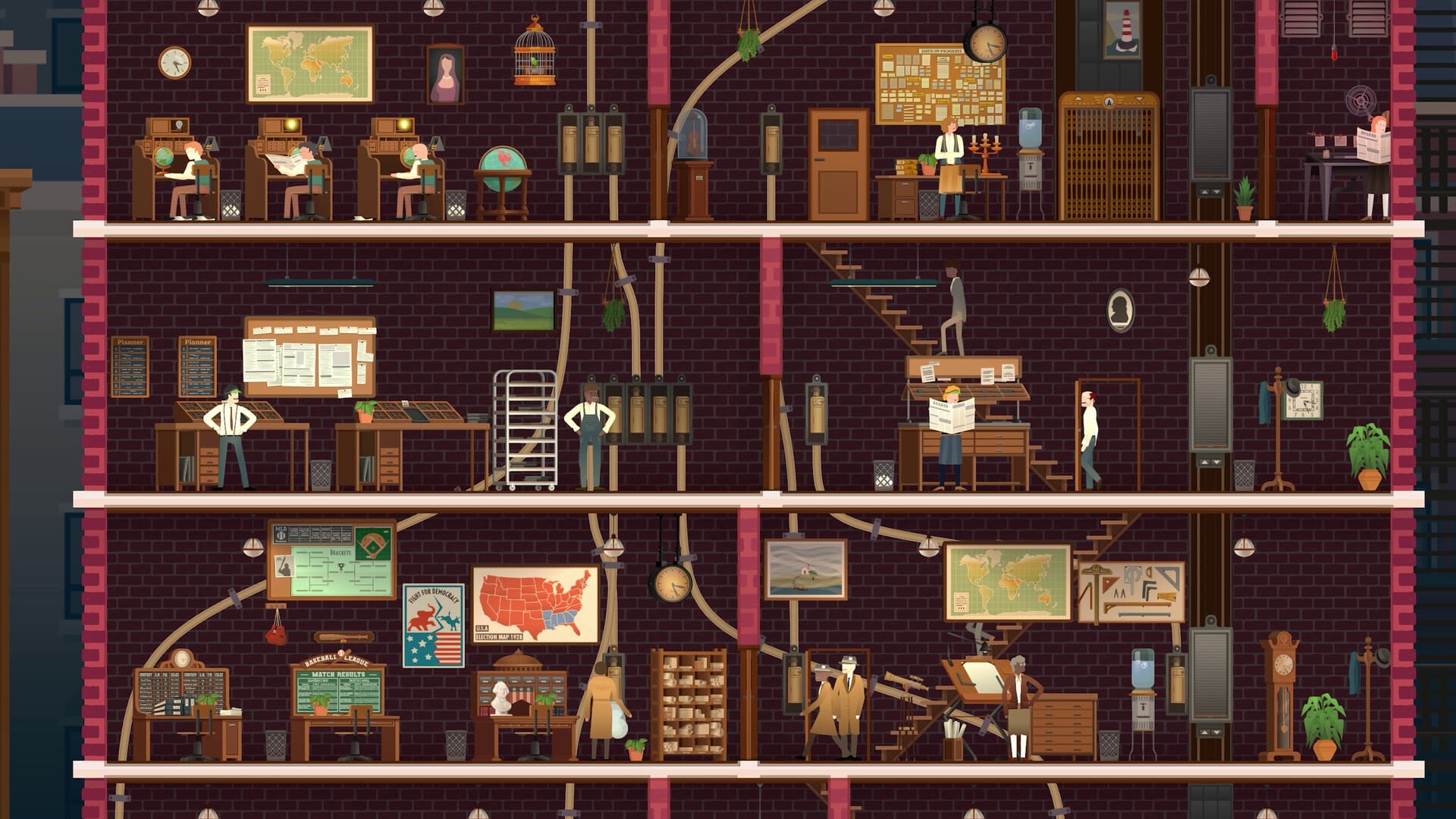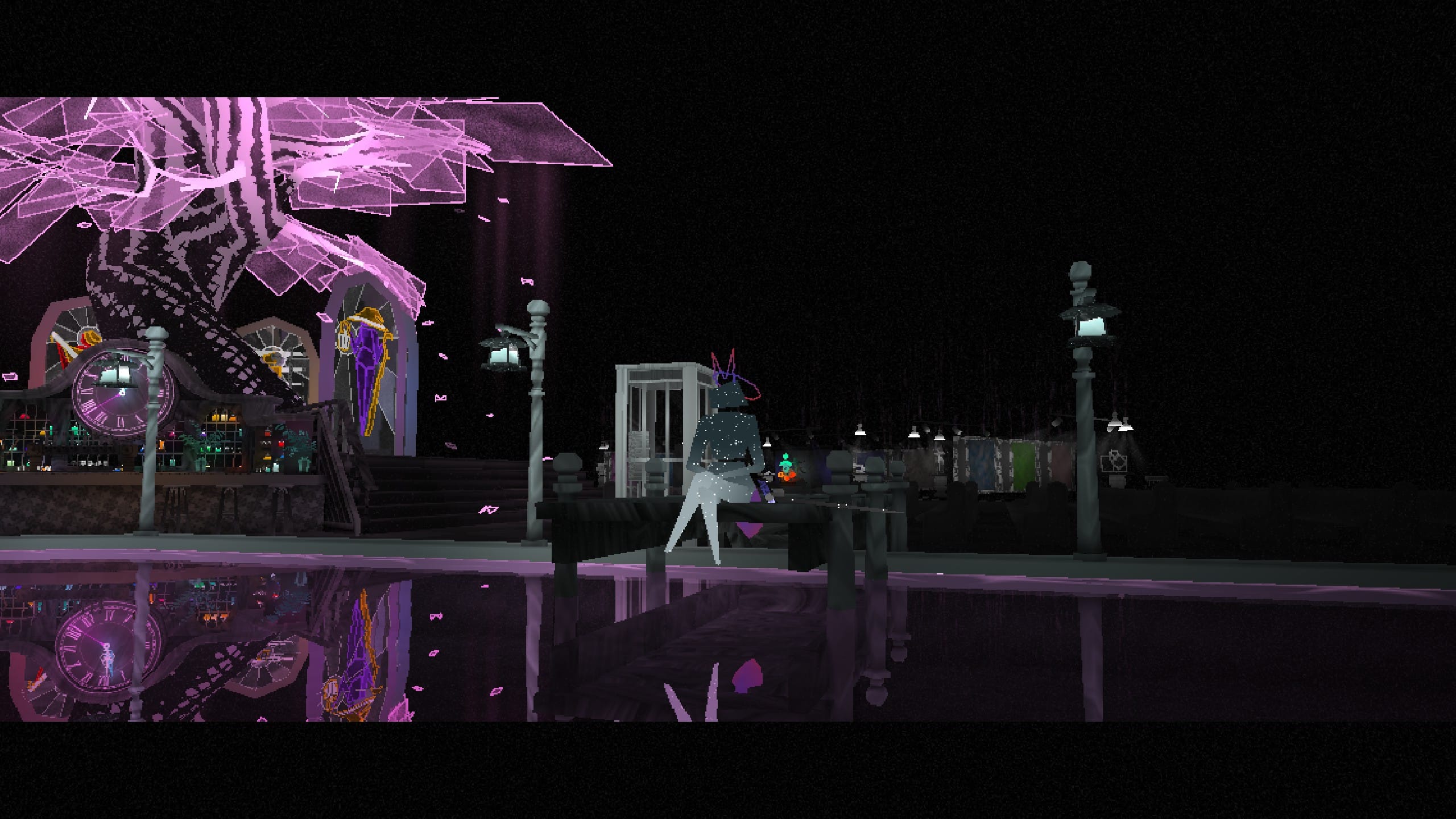Several runs deep into Wall World, I thought I had a good grasp of what it was. You play enough roguelikes and you can get a feel for what one of these games is pretty quickly: the loop, the progression, what an endgame run looks like, and so on.
But then I found a clearing deep in a cave. In the background, lush scenery: trees frame a waterfall in the center of the clearing. In the foreground, a long-abandoned spiderbot lay before me, a structure protruding from the wreckage (a weapon). It’s a striking scene – a departure from the barren view you get while scaling the wall outside – one with interesting implications for what the exact nature of the world is. But it also marked a change on a mechanical level, a change in how much I thought I knew the game.
Up till that point, Wall World had been… fine. It was a perfectly serviceable roguelike, but it felt staid. Movement was slow and plodding until you buy some upgrades, and combat was largely dull, success feeling dependent on getting the right spread of equipment after a certain point. Nothing too out of the ordinary for the early hours of some roguelikes, but Wall World at the time didn’t seem to have much else behind it. The loop seemed set, the possibility space clear. All that was left was to make it go faster and more efficiently until victory.

That moment in the cave changed that. It was the first step of many where I started making more meaningful progress and began to see the nuances at play, mechanically. New weapons made combat more exciting and active, forcing me to think about how best to clear waves of foes more efficiently. New equipment I hadn’t seen before was starting to appear, each one adding another layer of strategy to consider. Blueprints for new upgrades were regularly appearing, letting me acquire more tools that gave me a better shot at survival during runs and get up and running faster.
Wall World hit its stride and I was all in now.
Wall World is about scaling up and down a seemingly never ending wall to find the edge and hopefully learn its mysteries. Each run sees you stopping at mines to retrieve resources to upgrade your mining tools and your spiderbot’s equipment to move faster and survive against the monsters that patrol the skies. At the end of each run you spend points you’ve collected from mining on permanent upgrades to the spiderbot that enhances its abilities or adds new functions entirely, each one either increasing your chances of survival or making the mining process faster.

It’s effectively a mix of exploration and light tower defense. When you enter a mine, the spiderbot parks itself on top of the entrance. You only have so much time to dig around before you need to run back and take control to defend your transport. You can sometimes build towers or find a turret drone to provide additional firepower to cut through the enemies quickly (or maybe give you some more time in the mines if you’re feeling daring), but often you’re on your own.
It’s a compelling loop. Knowing you only have so much time to mine before the next wave of monsters arrives adds ample tension when you step away from the spiderbot. In bigger mines, that tension is increased tenfold given how long it can take to move back and forth between the spiderbot and however far you’ve dug. As caves become harder to drill through when tougher material becomes more common, it forces you to think about just how much it’s worth trying to clear every mine you come across versus just taking what you can get – what you need – before moving to the next.
Compounding this is a timer. Every 20 minutes a large beast known as “leviathan” descends on you. It confines you to a limited area as constant hordes of monsters attack in unison. The time leading up to these encounters is essentially spent preparing for them. At first, every time the timer expired, it was basically game over. I could see how it was possible to survive, but I didn’t have the means to do so. The spiderbot’s base movement speed was too slow to avoid attacks and I didn’t have any of the upgrades that would let me move up or down a set distance instantly, nor did the bot have enough health to take many hits, nor did I have the resources to make repairs with.

It was this that made the early game feel lacking. Devoting 20 minutes per run, several of them spent getting to a state where movement and combat started to feel passable, only to end suddenly because you can’t fight back against the big monster yet doesn’t feel great. Granted, progress is often slow to start with roguelikes, but there’s a difference between progression being protracted and the game itself not feeling great to start.
Roguelikes sometimes take a while to get going. For every Hades or Dead Cells that immediately gets its hooks in, there are plenty that are a slow burn by comparison. That’s not necessarily a bad thing, though it can make for an underwhelming first impression. Dreamscaper was one that had all the makings of a great roguelike (and it was!), but slow to unfurl. The foundation was there, it just took time for it to really shine. Wall World is similar in that regard, though in a different capacity.
Where Dreamscaper‘s problems were in how plodding and incremental progress was to a fault, Wall World is one of the early goings being consistently weak because it’s slow to start. The default movement speed doesn’t feel great. It’s so slow — enough to make getting around a chore, almost. Likewise, the rotation speed for the spiderbot’s gun is similarly sluggish. You can fix those quickly (the first upgrades are easy to obtain), but that this is the state you begin the game in while you work to get the fun stuff doesn’t make a great first impression.

It wasn’t until I found some blueprints that the slow start was no longer an issue. In particular, one device granted me a noticeable boost to my movement and mining speed as long as I was within a certain distance of the spiderbot. With that, I could almost always collect enough ore to let me increase those stats further to where movement always felt good from the get-go. From there, Wall World was constantly getting better. The time it took to go from nothing to having a fully fleshed out build got faster and faster, making it easier to get to the best parts of the game.
Wall World is at its best when you have a few modules and a couple extra weapons. Combat starts to shine because of how much decision making occurs, the layers of strategy that unfold. Some weapons can adjust their aim faster than others, encouraging you to swap to a faster one to get a shot lined up before swapping to the one you want to use, while others still require either pin-point precision or let you just spray and pray. As enemies get stronger, it makes even the smallest encounters more interesting because of the wealth of options you now have. Combined with how mobile the spiderbot can become, encounters with the leviathan become exciting as the intensity of combat only increases.
Faster movement speed and more efficient mining lets you collect resources faster and easier to focus more on finding the places you want to mine from to get the materials you need to get the stat buffs you want, the new abilities and functions you need. Earning the points you need to spend on permanent upgrades becomes effortless, allowing you to choose what to invest in rather than choose whatever the cheapest option is. At a certain point, I was earning so much so fast that I was able to afford multiple upgrades between runs consistently, making every new run a chance to try something new or see how much stronger I had become.
Once Wall World hits its stride, it’s great. The exploration and tower defense elements mix perfectly. Like any good roguelike, I had a few “just one more run” moments. You just have to be willing to get over the initial hurdle the early goings impose on you.





